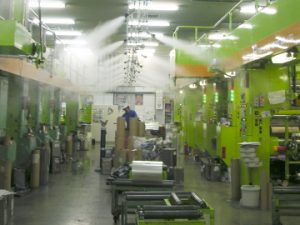Fogging Systems
AirAKI®

Features
Product outline
AirAKI® is an industrial humidification system, whose fog does not wet anything it touches, also known as Dry Fog®. The required fog evaporation distances between the product and the surrounding objects should be of a 4-meter circumference. Mounting the product at the suggested distance ensures that condensation is prevented. Moreover, thanks to its innovative design, it is possible to accommodate a wide range of industrial demands and requirements.
With this system, you can control the relative humidity levels in either large spaces or narrowly defined locations, thus eliminating the issues caused by static electricity.
Besides regulating the indoor humidity, the AirAKI® can yield a high-quality fog while requiring the running cost of 1/5 of a comparable steam humidification system, resulting in dramatic energy savings.
The solution includes not only the AirAKI® system, but also customer support on-site investigation, layout design, installation work, and after-sales services.
The main features of the spray humidifier technology system -AirAKI®
- Energy-saving pneumatic spray humidifier technology system producing Dry Fog;
- Preventing dryness and static electricity, thus enabling higher manufactured product quality and lower defect rates;
- Running cost of 1/5 compared to a steam humidification system, which in time leads to a ROI;
- Production of 2.4–9.6 liters/hour of Dry Fog with only one humidifier (when using AKIMist® “E” Dry fog type of humidifier).

To ensure AirAki® ‘s performance and functionality, we recommend using filtered water instead of tap water. The reason why tap water is not recommended for a humidifier is that it contains minerals that accumulate within the humidifier’s body, creating a suitable environment for the appearance of bacteria. Moreover, it induces the possibility of clogging. It is necessary to install a water filter and pass water through a reverse osmosis system that can clear and purify the water of impurities, particles, and minerals that might affect the working environment.
What is the difference between AirAki® and other humidifiers?
To begin with, AirAki® combines the water and the air in a process that is called impingement. The result of impingement leads to the development of Dry Fog. Dry Fog displays the characteristics of a very fine fog with a uniform mean droplet diameter of 10 μm or less. Its fine spray droplets maintain intact when entering in contact with objects such as walls and people, and they do not wet these surfaces.
For industrial use, air humidification can be achieved through various types of humidifiers such as:
- direct air humidifier
- high pressure spray humidifier
- Warm mist humidifiers
- Cool-mist humidifiers
- Steam humidifiers
However, the level of energy humidity control requires, depends on the type of selected humidification system. In certain cases, it is necessary for a system to boil the water, and to transform this boiled hot water into water vapor. This process is more costly also in the case of water consumption and energy utilization. For more information about other types of humidifiers click here.
Applications
- Static electricity prevention: Prevents/reduces troubles caused by static charge, such as product damage, (electrostatic damage) and debris/dust adhesion, etc.
- Energy saving: The running-costs of our system are only 1/5 of a typical steam humidification system, resulting in drastic energy savings.
- Cooling effects: The system also yields a cooling of about 2℃, reducing the temperature with evaporative cooling (using the principle of heat loss due to water evaporation of Dry Fog).
- Health-related benefits: Maintaining the levels of humidity (relative humidity) to 50% dramatically reduces cold viruses, influenza (flu) viruses, and so forth, thus reducing worker absences caused by illness.
In specific industries
- Preventing electrostatic discharge damage during assembly, mounting/installation and tests; preventing debris and dust adhesion; mitigating rises in incorrect-chucking rates; preventing mounting errors.
[Paper & Pulp, Printing]
- Rotogravure printing: Preventing ink pan and ink roll fires, preventing debris and dust adhesion to films and papers, dust suppression, reducing ink striation from doctor and/or plate cylinder, preventing adhesion of debris caused by ink’s electrostatic charge.
- Screen printing: Preventing print defects caused by feathering, misregistration, streaks, blurring, etc.; preventing fading caused by plate dryness; productivity improvements.
- Offset printing: Controlling moisture content of paper; preventing paper break (web break), jams, and misalignment; reducing paper tearing; improving folding precision; preventing color drift; preventing curl.
- Others: Form printing, humidification for cardboard production.
- Preventing dust and debris adhesion in the body and bumper coating, inspection processes; dust suppression in storage rooms; static charge prevention in vehicle electrical components production and circuit board mounting process; heatstroke countermeasures; shortening cycle times.
[Plastics production]
- Reducing work efficiency declines caused by static electric shock, preventing fires, preventing scattering of debris and body hair, preventing adhesion of debris, preventing toppling of stacked items caused by static electricity.
[Inks, Paints and Coatings]
- Preventing debris adhesion in painting/coating process; cissing prevention; preventing fires during paint/coating preparation processes, in areas around reaction tanks and mixers, and during filling processes for substances such as pigments and coatings.
[Other industries]
- Humidification and dust control in machine parts production, textile industry, agriculture, livestock and warehouses, etc.
Case Studies
Here are some example of successful humidification installation with the AirAKI® system and the Dry Fog humidifier AKIMist®”E”:
